Naming compounds - Study guides, Class notes & Summaries
Looking for the best study guides, study notes and summaries about Naming compounds? On this page you'll find 581 study documents about Naming compounds.
Page 4 out of 581 results
Sort by

-
IB Chem naming organic compounds Question and answers rated A+ 2023/2024
- Exam (elaborations) • 3 pages • 2024
- Available in package deal
-
- $14.49
- + learn more
IB Chem naming organic compounds Question and answers rated A+ 2023/2024Meth - correct answer 1 Eth - correct answer 2 Prop - correct answer 3 But - correct answer 4 Pent - correct answer 5

-
Culinary Chemistry Exam 1 Questions and Answers 2024 Graded A.
- Exam (elaborations) • 33 pages • 2024
- Available in package deal
-
- $12.99
- + learn more
Culinary Chemistry Exam 1 Questions and Answers 2024 Graded A. A chemical process of reflux can be used to determine the amount of ______ in foods. - ANSWER Fat _________ are known to build and repair tissue. - ANSWER Proteins The FDA allows for _______ % leeway in information reported on nutrition labels. - ANSWER 5 A cheeseburger from a fast food restaurant contains 19 g of fat, 20 g of carbohydrate, and 28 g of protein. How many kcal of energy does the cheeseburger contain? (The calor...
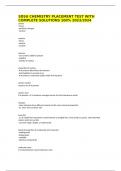
-
SDSU CHEMISTRY PLACEMENT TEST WITH COMPLETE SOLUTIONS 100% 2023/2024
- Exam (elaborations) • 6 pages • 2024
- Available in package deal
-
- $10.50
- + learn more
SDSU CHEMISTRY PLACEMENT TEST WITH COMPLETE SOLUTIONS 100% 2023/2024 proton -heavy -positively charged -nucleon neutron -heavy -neutral -nucleon electron -very small (1/1800 of proton) -negative -outside of nucleus properties of nucleus -# of protons determines the element -held together by nuclear force -# of protons is extremely stable unlike # of electrons atomic number equal to the # of protons atomic mass # of protons + # of neutrons averaged across a...

-
SDSU CHEMISTRY PLACEMENT TEST WITH COMPLETE SOLUTIONS 100% 2023/2024
- Exam (elaborations) • 6 pages • 2024
-
- $10.19
- + learn more
SDSU CHEMISTRY PLACEMENT TEST WITH COMPLETE SOLUTIONS 100% 2023/2024 proton -heavy -positively charged -nucleon neutron -heavy -neutral -nucleon electron -very small (1/1800 of proton) -negative -outside of nucleus properties of nucleus -# of protons determines the element -held together by nuclear force -# of protons is extremely stable unlike # of electrons atomic number equal to the # of protons atomic mass # of protons + # of neutrons averaged across a...
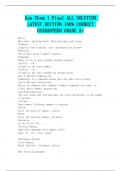
-
Gen Chem 1 Final ALL SOLUTION LATEST EDITION 100% CORRECT GUARANTEED GRADE A+
- Exam (elaborations) • 10 pages • 2024
-
- $12.99
- + learn more
Matter Most basic building block. Must have mass and volume Elements Simplest form of matter, can't decompose any further Molecules Two or more atoms "linked" together Compounds Mixes of two or more elements bonded together Sig Fig.- x & / As many as the least number Sig Fig.- + & - As many as the least behind the decimal point Law of Definite Composition Components in a compound always have the same ratio by mass Law of Multiple Proportions Ratios of elements that combine to m...

-
Industrial Applications of Organic Chemistry
- Exam (elaborations) • 14 pages • 2024
-
- $8.99
- + learn more
Unit 28: Industrial Applications of Organic Chemistry Unit code: H/502/5573 QCF Level 3: BTEC National Credit value: 10 Guided learning hours: 60 Aim and purpose The aim of this unit is to familiarise learners with the structure, naming and properties of a range of organic compounds and to investigate the industrial uses of these compounds. Unit introduction The majority of the substances we use every day are, or contain, organic compounds. Pharmaceuticals such as aspirin and parac...
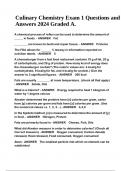
-
Culinary Chemistry Exam 1 Questions and Answers 2024 Graded A.
- Exam (elaborations) • 33 pages • 2024
- Available in package deal
-
- $13.99
- + learn more
Culinary Chemistry Exam 1 Questions and Answers 2024 Graded A. A chemical process of reflux can be used to determine the amount of ______ in foods. - ANSWER Fat _________ are known to build and repair tissue. - ANSWER Proteins The FDA allows for _______ % leeway in information reported on nutrition labels. - ANSWER 5 A cheeseburger from a fast food restaurant contains 19 g of fat, 20 g of carbohydrate, and 28 g of protein. How many kcal of energy does the cheeseburger contain? (The calor...
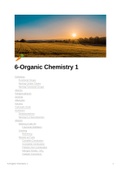
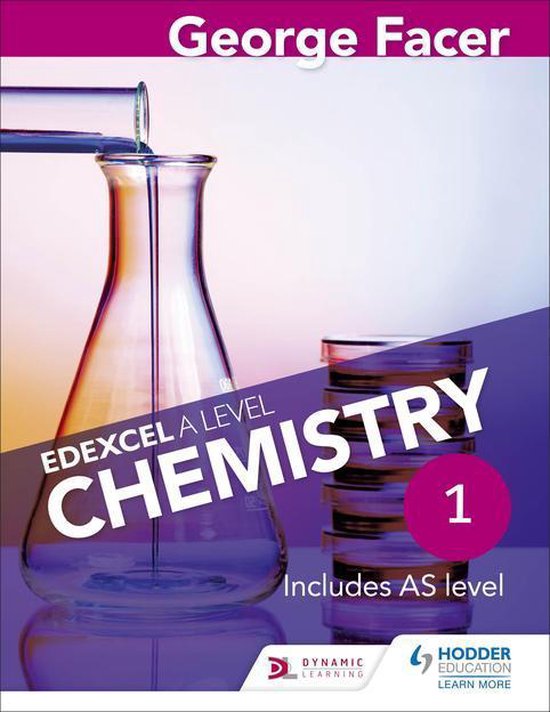
-
A Level Edexcel Unit 6 - Organic Chemistry I notes written by a 3A* Imperial College London Medicine Student
- Summary • 35 pages • 2023
-
- $3.90
- 4x sold
- + learn more
Detailed notes on Unit 6 - Organic Chemistry I covering all specifications points, and allowed me to achieve an A*. Covers bonding, types of formula, homologous series, naming organic compounds, isomerism, type of reactions, alkanes, alkenes, free radical substitution, electrophilic addition, halogenoalkanes, nucleophilic substitution, uses of halogenoalkanes, oxidation and combustion of alcohols.
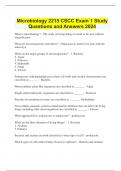
-
Microbiology 2215 CSCC Exam 1 Study Questions and Answers 2024
- Exam (elaborations) • 8 pages • 2024
-
- $11.99
- + learn more
What is microbiology? - The study of living things to small to be seen without magnification What are microorganisms (microbes)? - Organisms to small to be seen with the naked eye What are the major groups of microorganisms? - 1. Bacteria 2. Algae 3. Protozoa 4. Helminths 5. Fungi 6. Viruses Prokaryotes with peptidoglycan in their cell walls and circular chromosomes are classified as ______. - Bacteria Photosynthetic plant-like organisms are classified as ______. - Algae Sing...
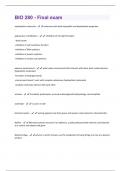
-
BIO 280 - Final exam Questions & Answers Already Graded A+
- Exam (elaborations) • 10 pages • 2024
- Available in package deal
-
- $7.99
- + learn more
amphipathic molecules - molecules with both hydrophilic and hydrophobic properties approaches of antibiotics - -inhibition of cell wall formation --beta lactam -inhibition of cell membrane function -inhibition of DNA synthesis -inhibition of protein synthesis -inhibition of nucleic acid synthesis aqueous environment - -polar water environment that interacts with other polar molecules/ions (hydrophilic molecules) -formation of hydrogen bonds -environment doesn't react with nonpolar sub...

How much did you already spend on Stuvia? Imagine there are plenty more of you out there paying for study notes, but this time YOU are the seller. Ka-ching! Discover all about earning on Stuvia


